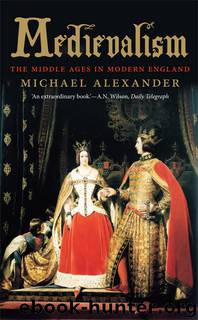Medievalism: The Middle Ages in Modern England by Michael Alexander

Author:Michael Alexander [Alexander, Michael]
Language: eng
Format: epub
ISBN: 9780300227307
Google: qZ4nvgAACAAJ
Amazon: 0300227302
Publisher: Yale University Press
Published: 2017-04-04T00:41:13.883000+00:00
CHAPTER 8
History and Legend
THE SUBJECTS OF POETRY AND PAINTING
The working definition of medievalism adopted at the outset of this essay in cultural history included a historical or textual component, so that a work might not be considered part of the Medieval Revival if it referred to a world of Gothic fantasy rather than to a historical or textual Middle Ages. The reverence for a historical Middle Ages felt by some artists and poets, if not the general public, reached a high-water mark in 1851, when the ‘Mediæval Court’ won plaudits at the Great Exhibition. This was also the year in which Ruskin, at the prompting of Coventry Patmore, wrote his letter to The Times defending the Pre-Raphaelites, an intervention which began the process of their acceptance.1 Soon they were being asked to paint everywhere.
It might seem tempting to regard the restoration of the English Catholic hierarchy in 1850 as part of the Medieval Revival. In England, Catholicism can seem medieval. Yet the Catholic Church existed before and after the Middle Ages, and is not limited to the millennium in which it helped to form England. The installation of Wiseman as Archbishop of Westminster, and of other Catholic bishops in England and Wales, was met by violent public protest. ‘Papal Aggression’ was represented as political, even territorial.2 Wiseman’s response was that the only subjects of Queen Victoria he coveted were the poor who clustered in the ‘rookeries’ of Westminster. What Newman in a sermon of 1852 called ‘The Second Spring’ of English Catholicism (the first being Augustine’s conversion of Saxon England) was mocked by The Times as ‘the Italian mission to the Irish’. In the course of the controversy surrounding the restoration of Catholic bishops there was much appeal to history, especially to the rights and wrongs of the English Reformation.
Since Pugin had published Contrasts (1836), and its second edition in 1841, he had been a leading public advocate of medieval ideals. In 1851 he published An Earnest Address, on the Establishment of the Hierarchy, which includes a surprising retractation. By some, Pugin writes, ‘All, anterior to the Reformation, is regarded and described as a sort of Utopia: – pleasant meadows, happy peasants, merry England . . . bread cheap, and beef for nothing, all holy monks, all holy priests, – holy everybody. Such charity, and such hospitality, and such unity, when every man was a Catholic. I once believed in this Utopia myself, but when tested by stern facts and history it all melts away like a dream.’3
This dream of the charity and piety of pre-Reformation England had inspired Pugin’s own ‘Contrasted Residences for the Poor’ of 1836 (see Plate 8). With one sweeping gesture, Pugin confesses that his youthful dream of the Middle Ages cannot stand up against history. What led him to apply the test of ‘stern facts and history’ may have been a new fact, the restoration of the hierarchy. After three penal centuries, English Catholics were permitted to practise their faith openly. A few penalties remained
Download
This site does not store any files on its server. We only index and link to content provided by other sites. Please contact the content providers to delete copyright contents if any and email us, we'll remove relevant links or contents immediately.
| Africa | Americas |
| Arctic & Antarctica | Asia |
| Australia & Oceania | Europe |
| Middle East | Russia |
| United States | World |
| Ancient Civilizations | Military |
| Historical Study & Educational Resources |
Elizabeth by Philippa Jones(1862)
Mary Boleyn by Alison Weir(1465)
Traitors of the Tower by Alison Weir(1359)
A Journal of the Plague Year (Oxford World's Classics) by Daniel Defoe(1228)
Eleanor of Aquitaine by Marion Meade(1084)
Moon Tiger by Penelope Lively(1070)
A Short History of England by Simon Jenkins(1066)
The Real Middle Earth by Brian Bates(1049)
Life of Pi by Yann Martel(1031)
London Under by Peter Ackroyd(1017)
Notes From a Small Island by Bill Bryson(1010)
Queen Isabella by Alison Weir(1005)
American Idol by Richard Rushfield(924)
Her Majesty's Spymaster by Stephen Budiansky(909)
Tudors Versus Stewarts by Linda Porter(905)
Albion by Peter Ackroyd(838)
Cromwell, Our Chief Of Men by Fraser Antonia(814)
The Creation of Anne Boleyn by Susan Bordo(813)
Children Of England: The Heirs of King Henry VIII 1547-1558 by Weir Alison(812)
